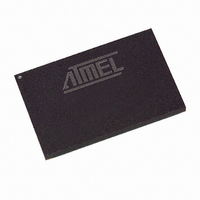AT91F40816-33CI Atmel, AT91F40816-33CI Datasheet - Page 6

AT91F40816-33CI
Manufacturer Part Number
AT91F40816-33CI
Description
IC ARM7 MCU 2M FLASH 120 BGA
Manufacturer
Atmel
Series
AT91SAMr
Datasheet
1.AT91F40816-33CI.pdf
(22 pages)
Specifications of AT91F40816-33CI
Core Processor
ARM7
Core Size
16/32-Bit
Speed
40MHz
Connectivity
EBI/EMI, UART/USART
Peripherals
WDT
Number Of I /o
32
Program Memory Size
2MB (1M x 16)
Program Memory Type
FLASH
Ram Size
8K x 8
Voltage - Supply (vcc/vdd)
2.7 V ~ 3.6 V
Oscillator Type
External
Operating Temperature
-40°C ~ 85°C
Package / Case
120-BGA
Lead Free Status / RoHS Status
Contains lead / RoHS non-compliant
Eeprom Size
-
Data Converters
-
Available stocks
Company
Part Number
Manufacturer
Quantity
Price
Company:
Part Number:
AT91F40816-33CI
Manufacturer:
XICON
Quantity:
43 000
Architectural
Overview
Memories
Peripherals
System Peripherals
6
AT91F40816
The AT91F40816 integrates Atmel’s AT91M40800 ARM Thumb Microcontroller and an
AT49BV1604/1614 16 Mbits, 2.7-Volt Read and 2.7-Volt Byte-Write Sectored Flash
memory die in a single compact 120-ball BGA device. The address, data and control
signals, except the Flash memory enable, are internally interconnected.
The architecture consists of two main buses, the Advanced System Bus (ASB) and the
Advanced Peripheral Bus (APB). Designed for maximum performance and controlled by
the memory controller, the ASB interfaces the ARM7TDMI processor with the on-chip
32-bit memories, the External Bus Interface (EBI) and the AMBA
Bridge drives the APB, which is designed for accesses to on-chip peripherals and opti-
mized for low power consumption.
The AT91F40816 implements the ICE port of the ARM7TDMI processor on dedicated
pins, offering a complete, low-cost and easy-to-use debug solution for target debugging.
The AT91F40816 embeds 8K bytes of internal SRAM. The internal memory is directly
connected to the 32-bit data bus and is single-cycle accessible.
The AT91F40816 features an External Bus Interface (EBI), which enables connection of
external memories and application-specific peripherals. The EBI supports 8- or 16-bit
devices and can use two 8-bit devices to emulate a single 16-bit device. The EBI imple-
ments the early read protocol, enabling faster memory accesses than standard memory
interfaces.
The AT91F40816 embeds a Flash memory organized as 1M 16-bit words, accessed via
the EBI. Its main function is as a program memory. A 16-bit Thumb instruction can be
loaded from Flash memory in a single access. Separate MCU and Flash memory Reset
inputs (NRST and NRSTF) are provided for maximum flexibility. The user is thus free to
conform the reset operation to the application.
The AT91F40816 integrates resident boot software called AT91 Flash Uploader soft-
ware. The AT91 Flash Uploader software is able to upload program application software
into its Flash memory.
The AT91F40816 integrates several peripherals, which are classified as system or user
peripherals. All on-chip peripherals are 32-bit accessible by the AMBA Bridge, and can
be programmed with a minimum number of instructions. The peripheral register set is
composed of control, mode, data, status and enable/disable/status registers.
An on-chip Peripheral Data Controller (PDC) transfers data between the on-chip
USARTs and on- and off-chip memories address space without processor intervention.
Most importantly, the PDC removes the processor interrupt handling overhead, making
it possible to transfer up to 64K continuous bytes without reprogramming the start
address, thus increasing the performance of the microcontroller, and reducing the power
consumption.
The External Bus Interface (EBI) controls the external memory or peripheral devices via
an 8- or 16-bit databus and is programmed through the APB. Each chip-select line has
its own programming register.
The Power-saving (PS) module implements the Idle mode (ARM7TDMI core clock
stopped until the next interrupt) and enables the user to adapt the power consumption of
the microcontroller to application requirements (independent peripheral clock control).
The Advanced Interrupt Controller (AIC) controls the internal sources from the internal
peripherals and the four external interrupt lines (including the FIQ) to provide an inter-
™
Bridge. The AMBA
1348D–ATARM–03/04













